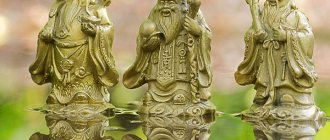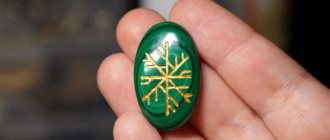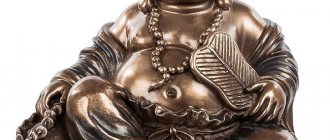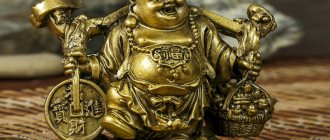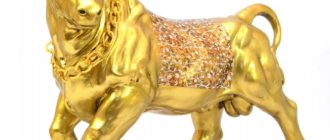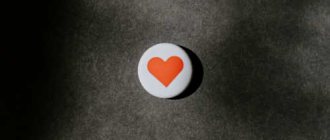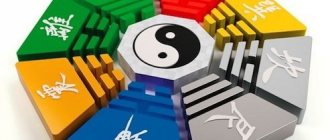An ancient legend about the origin of the device
This ancient device is considered to be the predecessor of the nautical compass. According to legend, it was invented by the Yellow Emperor, who ruled in the 4th century BC. The wise ruler compiled the first calendar, introduced such concepts as cycles and periods, heavenly trunks and earthly branches.
The great emperor was prompted to create the Lopan compass by certain events. Being a great warrior, he conquered many states. One day, the king of the kingdom that the Yellow Emperor was trying to capture, using witchcraft spells, created an impenetrable fog, depriving the enemy army of any ability to move.
The Emperor, who had psychic abilities, turned to the Goddess for help, who revealed some knowledge to him. She prompted the warrior to create Lopan, indicating detailed instructions for its manufacture. In that battle, the emperor managed to win. The ancient compass is used not only to determine the cardinal directions, but also as a measuring device in the ancient science of Feng Shui. The special branches of the Zi indicate the 12 animals used in the Chinese horoscope.
Facade and rear of the building
We have already become acquainted with the different types of compass and the distribution of degrees, now we need to determine the reporting point that serves for the analysis of Feng Shui. Typically this point is the main façade of the building.
In Feng Shui, the facade is considered the most important place for Qi energy to enter the space. For example, in a city apartment, the main facade is located where the main windows of the living room are or where the balcony overlooks the main street or area with the best views, while the front door may be in a completely different position. Therefore, it is necessary to avoid the common mistake of associating the front door with the facade, although very often these two concepts coincide in position.
Technically, Feng Shui expresses the facade as part of the yang, where activity, brightness rules and where Qi is directed. Openness and the absence of obstacles makes it easier to direct Qi to the home. The rear is considered to be the opposite part of the facade. In some Feng Shui systems, the rear determines the types of housing.
Compass device Lopan
The modern Chinese Luopan compass has a square base. Inside it there is a rotating disk, in the center of which there is a capsule with a magnetized moving arrow. The measurement, and therefore the accuracy of the results, depends on this arrow. The Chinese believe that it always points south. The sphere located in the middle of the device is called the “Heavenly Pond”. The main ring of the compass is followed by circles:
- Bagua Ring – “Early Sky”, which serves as protection.
- Ancient formulas of the science of Feng Shui - there are 36 of them in total, each sector consists of 24 segments.
The inner rings are divided into 8 trigrams with indications of the cardinal directions and other information. The following circles symbolically indicate the trunks of Heaven and the branches of Earth. The trunks include Yin and Yang, as well as the 5 main elements. The Black Turtle points to the north, the Crimson Phoenix to the south, the Green Dragon to the east, and the White Tiger to the west. In the center is the Yellow Dragon.
The branches contain the names of animals of the eastern horoscope: bull, tiger, rat, dog, monkey, horse, snake, dragon, rabbit, pig, rooster, goat. The outer circle has 360° markings. Today there are the following main types of Lopan compass:
We have selected interesting articles for you:
How do representatives of the elements Fire and Water get along?
11.12.2021
I Ching - Book of Changes
27.01.2019
- compass 3 combinations – San He;
- compass of 3 eras – San Yuan;
- a model that combines both is Zong He.
There are 2 red threads running through the entire compass, forming a cross in the middle of the “Sacred Pond”.
Which compass should I buy?
Above are examples of different compasses in ascending order, starting with the more affordable one with a moving needle, moving to the middle model with a rotating disk, and finally reaching Lo Pan. If you want to purchase a compass that will guarantee more accurate measurements, here are some tips to consider
One important point is the degree accuracy . In this case, the smaller the scale, the more accurate the measurement. The recommended minimum is a transition of 2 to 2 degrees; for professional measurements it is advisable to reduce the scale to 1 or 0.5 degrees
The worthy Luo Pan gives us an accurate reading of degrees due to the vastness of the disk.(photo).
The next point, not so important, is the system of horizontal and vertical alignment , which presumably serves to facilitate the free movement of the magnetic needle.
Note: In actual practice, what you should keep in mind is the buoyancy of the magnetic needle itself. There may be a case where the levels are located correctly, but the arrow does not move, so it is advisable to concentrate only on the movement of the arrow.
If you want to purchase Lo Pan , you should pay attention to such things as the exact location of the threads dividing the disk , checking their exact parallelism in sections (North-South or 0-180 degrees, East-West or 90-270 degrees), also watch correct movement of the disc and, most importantly, that the inner arrow is of high quality. In terms of accuracy, these final details are details of utmost importance. For Western compasses, use a quality brand.
It is worth spending a little more when purchasing a quality compass, as in the end its accuracy and good use can make the difference between a correct and incorrect feng shui map.
How to use a compass
The lopan should be positioned horizontally, while the arrow moves freely. It is necessary to move the thread so that it is directed in a straight line towards the object. After this, you need to slowly rotate the disk with your thumbs until the diameter of the circle and the arrow coincide. Signs and text will help determine the exact direction.
When using a compass, you need to consider that there is a front and a back side. To determine the rear direction, you need to count 180° from the side of the facade. It is necessary to take into account the features of different types of compasses. Thus, using information related only to the formulas of San He, it is impossible to understand the structure of San Yuan. Before making calculations, you must carefully study the tables supplied with the device.
Nuances when taking measurements using it
All Lopan trigrams have their own interpretations. For better understanding, they are divided into the following groups:
- 3 lines – northwest, metal, sky, old man;
- 1 flat stripe between 2 dotted ones - north, water, middle-aged man, winter, ears;
- 1 solid with 2 broken ones under it - northeast, earth, youngest son, mountain, hands;
- 1 solid and 2 intermittent above it - east, tree, eldest son, spring, legs, thunder;
- 1 intermittent and 2 solid above it - southeast, daughter, tree, wind, buttocks;
- 1 intermittent surrounded by 2 solid ones - south, fire, elderly woman, summer, eyes;
- only intermittent - southwest, earth, stomach;
- 1 intermittent and 2 solid under it - west, metal, girl, autumn, mouth.
When measuring space using Lopan, it is necessary to remove all metal objects. Due to electromagnetic interference, the arrow constantly rotates in different directions.
Academy of Metaphysics Victoria Baykova
Correct determination of directions is an integral part of the application of Qi Men Dong Jia techniques.
The main tool used in both Feng Shui and Qimen to measure directions is the Chinese compass or Lopan.
In fact, Lopan was the predecessor of the sea compass. The first mention of a Chinese compass dates back to the 4th century BC, almost 1,500 years before the compass was used for navigation in Europe around 1190 AD. Even in China, the compass was not used in navigation until probably 850 BC. e. Before this, it was only used for movement on Earth and Feng Shui. Wang Chi (who lived during the Song Dynasty, 960 - 1127) developed Luo Pan in the form in which it is used today, with approximately 17 rings. On one of these rings 24 directions were indicated.
Modern Lopan is a wooden disk (15-25 cm in diameter), freely rotating on a square base. Two lines made of red thread run across the compass from one side to the other, forming an optical crosshair. In the center is a glazed cavity containing a suspended magnetized needle. The needle points north, although the Chinese believe it points south. In the West, it is believed that in the same instrument, the magnetized tip of the needle points to the magnetic pole of the Earth.
The compass disk contains a series of concentric rings containing a huge amount of information about Feng Shui, captured in Chinese characters, although Lopan with inscriptions in English has now become widespread.
The rings of the Chinese compass are called "tsen", which means "layers". A compass can have from 7 to 39 such rings. Compass sizes can range from 6 cm to 1 meter in diameter. Very small compasses can be inaccurate, and ones that are too large can be difficult for one person to handle. There are basic rings that are required for all compasses. In addition to them, there are special rings used in one or another Feng Shui school or even just by different Feng Shui masters.
Rings are cut out, painted or engraved on the surface of the disk. each ring is divided into sectors from (8 to 720). The hieroglyphs in each sector are written in black, red or gold. The good thing about the Chinese language is that characters take up much less space than English words with the same meaning. Thanks to this, you can fit a huge amount of information on one compass.
When using a compass for Feng Shui or Qi Men purposes, it is important to remember that a Western compass measures points, while a Chinese compass measures sectors. For example, south on the western compass is a point located exactly 180°. On the Chinese compass, south ranges from 157.5° to 202.5°. In other words, it is a 45° sector with a center at 180°. Remember that there are 8 directions of 45° = 360°. To be more precise, the middle of the south (or direction Y).
So, the Western compass measures points, while the Chinese compass measures sectors. In Qi Men, although sometimes we will have to make very precise measurements, it will be enough for us to determine within which sector of 8 the place we need will be located.
Chinese Luopan is a kind of round Lo Shu. You can start with Lo Shu and from its directions build a circle with 24 directions. Representing Lo Shu as a circle, we get something similar to the figure below.
Although in Qi Men we will not need to divide it into 24 mountains, nevertheless, for a closer acquaintance with Lopan, I will give it here. To do this, we divide each of the 8 directions into 3 sectors, which will give 24 directions.
This ring has 24 segments, which are usually called directions, or in Chinese 24 "shan" (mountains). Each of these 24 directions constitutes a sector of 15°
What's on this ring? It consists of three sets of symbols already known to us: trigrams, Earthly branches and Heavenly trunks. As you know, the total number of trigrams is 8, but on the ring of 24 mountains only 4 of them are located: Kun, Qian, Gen and Xun, meaning Earth, Heaven, Mountains and Wind. These trigrams indicate corner points: SW, NW, SE, NE. The remaining elements of the 24 rings are Earthly branches - 12 and Heavenly trunks - 10. Total - 24 elements.
The table below shows the correspondence of mountain names with the conventional designation we have adopted and the degree system.
| Direction | Designation | Mountain | Polarity of the mountain | Degrees |
| Yu1 | Bean | Jan | 157,5 — 172,5 | |
| South | Yu2 | U | Yin | 172,5 — 187,5 |
| Yu3 | Dean | Yin | 187,5 — 202,5 | |
| SW1 | Wei | Yin | 202,5 — 217,5 | |
| Southwest | SW2 | Kun | Jan | 217,5 — 232,5 |
| SW3 | Shen | Jan | 232,5 — 247,5 | |
| Z1 | Geng | Jan | 247,5 — 262,5 | |
| West | Z2 | YU | Yin | 262,5 — 277,5 |
| Z3 | Xin | Yin | 277,5 — 292,5 | |
| SZ1 | Xu | Yin | 292,5 — 307,5 | |
| Northwest | SZ2 | Qian | Jan | 307,5 — 322,5 |
| SZ3 | Hai | Jan | 322,5 — 337,5 | |
| C1 | Ren | Jan | 337,5 — 352,5 | |
| North | C2 | Tzu | Yin | 352,5 — 7,5 |
| C3 | Gui | Yin | 7,5 — 22,5 | |
| SV1 | Chow | Yin | 22,5 — 37,5 | |
| Northeast | SV2 | Gen | Jan | 37,5 — 52,5 |
| SV3 | Yin | Jan | 52,5 — 67,5 | |
| IN 1 | Jia | Jan | 67,5 — 82,5 | |
| East | AT 2 | Mao | Yin | 82,5 — 97,5 |
| AT 3 | AND | Yin | 97,5 — 112,5 | |
| SE1 | Chen | Yin | 112,5 — 127,5 | |
| Southeast | SE2 | Xun | Jan | 127,5 — 142,5 |
| SE3 | Sy | Jan | 142,5 — 157,5 |
Note that the 12 branches occupy every second sector and that the trigrams occupy corner positions. The heavenly trunks are placed so that they fall on their corresponding element and alternate between yang (+) and yin (-).
In relation to Qi Men, at the first stage we use the Luo Pan compass to determine one of the eight directions. We will need compass measurements to determine the direction of movement in Dynamic Qi Men. And also to divide our apartment or office in which we work into sectors of the Lo Shu square in accordance with the cardinal directions.
How to take readings from a traditional Lopan compass
How do you know which direction the front door of your house is oriented? Walk out the door and hold the compass with both hands so that the edge of the square compass panel is parallel to the door. Keep the compass parallel to ground level. Using your thumbs, slowly rotate the dial until the needle is directly above the red line. Make sure the small tip end of the needle is between two points on the base.
If the compass seems to be shaking, place it on a wooden stand at waist level. Do not use a metal tripod as metal may distort the readings. Now look at the crosshairs. One of its blue components makes a right angle with the door. Where it intersects the ring of directions furthest from the door is the direction of the façade. When you find this direction, consider that you have taken a reading from the Lopan compass.
Where the same red line crosses the direction ring closest to the door is the rear direction. It is always located opposite the facade.
How to take readings from a hiking compass
Stand with your back to the door. keep the compass parallel to the surface of the earth. If it is a simple compass, then turn it until the needle points north. Look at the number of degrees indicated on the compass point farthest from the door. This is the direction of the facade.
In the table above, find which of the 8 directions corresponds to the number of degrees you get. The rear direction is determined by adding 180 degrees to the front direction.
Determine the direction of the front and back of your home.
Circle of Old Heavens
This circle has a second name - the primordial Bagua indicates the order of things in the Universe, describes the original world of Tao and the laws of existence. The energy of the Tao world is beyond time and space. It is everywhere: in things, objects. Feng Shui masters use this energy to influence the flow of earth energy.
The circle of the former heavens can tell about the order of things in the Universe. In this circle in the south is the sky (Qian), in the north - earth (Kun), in the east - fire (Li), in the northwest - mountain (Gen), in the west - water (Kan), in the northeast - thunder (Zhen), in the southeast - a body of water (Dui), in the southwest - wind-tree (Sun). Balance is achieved by opposing positions. Each pair contains three Yin traits and, similarly, three Yang traits.
Thanks to the circle of the former heavens, one can learn the order of things in the Universe by making a complete revolution in a circle. Moving clockwise from the trigram Zhen (thunder) to Qian (sky), you can see the changes that occur as Yin and Yang wax and wane.
Yang energy begins in the northeast, reaching its highest point in the south. This is indicated by three straight lines.
Yin energy begins in the southwest, in the zone of the trigram Sun (wind), reaching its highest point in the north. This means the dotted lines of the trigram Kun (earth).
During the birth of one energy, the other necessarily weakens, and this moment is considered the beginning of a new cycle.
Source: 1fenshui.ru
Determining the cardinal directions in your home using a compass
First, draw up an accurate floor plan of your apartment to the correct scale and divide each width and height into three equal parts.
The result should be a 3x3 rectangular grid of 9 identical squares or rectangles. If your apartment has an irregular shape, for example L-shaped, then bring it to the correct shape, roughly drawing it to a rectangle.
Give each square a different direction. These squares are called palaces.
The palace lying in the part of the house that faces the North will be northern. The opposite of it is southern, and so on. In an irregularly shaped apartment, some palaces may be missing.
Two examples of how to divide a house plan into 8 palaces
Let's say you get a measurement of 350 degrees. According to the table, this is North. The axis relative to which the house is oriented in space is North-South. We write down North and South in the upper and lower central cells, and then we paint all the other palaces.
If you get 260 degrees as a result of measurements, then the axis is West-East. In this case, we write West and East in the upper and lower central squares, and then, as in the first example, we paint all the other palaces according to the cardinal directions.
Note! In the standard Loshu square, the South is always located at the top, but you need to expand it in relation to your room.
Each of the sectors in the house has its own individual energy and is associated with a specific Bagua trigram. If any sector is out of order, then everything associated with this trigram is in a vulnerable state.
Another way to find out the energy of a sector is to use the Flying Stars method. Flying stars are types of energies that constantly move around the house and change its feng shui.
Source: art-fenshui.ru
Lo Pan - standard popular compass
Lo Pan uses a moving pointer system and an external disk full of information that is manually adjusted.
This compass usually has two threads dividing the disc into 4 sections, accurately indicating the simultaneous reading of the degrees of the front, rear and two sides as the 4 tutelary animals of Feng Shui.
There are different types of Lo Pan, which mainly differ in their bodies. We can find traditional models created for the San-Yuan, San-Hi systems, as well as those made to the taste of an individual master.
The Lo Pan disk has many concentric information rings, which indicate:
- eight trigrams,
- eight directions,
- 24 mountains,
- sky pillars,
- 28 constellations,
- earthly branches and much more.
Some Lo Pan rings are used in Feng Shui Yin, the study of burials and grave location. Nowadays, many Grand Masters focus their attention on Feng Shui Yang, that is, the world of living people, housing, workspace, etc.
In addition, there are electronic compasses that provide a quick reading of degrees, although if we use a classic compass we will have the advantage of an additional tool!
Basic theory of cardinal directions
The compass is divided into 360 degrees. What happens if we want to find out the degrees of the 4 cardinal directions? We just need to divide 360 degrees into 4 parts and we get north, south, east, west, occupying each 90 degrees.
North will be between 315 and 45 degrees, east between 45 and 135 degrees, south between 135 and 225 degrees and west between 225 and 315 degrees. On a more precise scale, like 8 main divisions, we would have to divide 360 degrees by 8, that is, 45 degrees for each division.
8 main directions
Note that north does not end at 45 degrees, but at 22.5, the result of dividing absolute north (360 degrees) into 2 parts, distributing 22.5 degrees on either side. North falls on the 8-part scale from 337.5 to 22.5 degrees. Subsequent directions are calculated in a similar way at intervals of 45 degrees.
24 directions or mountains
Here we should divide 360 degrees into 24 directions.
This way we get parts of 15 degrees each. The 8 main directions are in turn divided into three categories, South1, South2, South3, North1, North2, North3, etc. 24 mountains are used for more in-depth measurements using the Xuan Kong Feng Shui system method.
Source: www.fengshuinatural.com
Basic recommendations for making accurate calculations
Note that you should never draw conclusions about at right angles to the object whose direction you are measuring. Keep the compass at waist level. This usually gives the best results when analyzing the flow of chi in your home. When measuring directions in new homes, keep in mind that builders typically take measurements on the floor. Differences in compass readings taken at floor level and a meter from the ground can reach 10-15°.
Please remember that the electromagnetic field can greatly affect compass readings. Among the many different factors that affect the operation of a compass, metal objects and modern electronic equipment have the most adverse effects.
I advise you to measure any direction at least three times from different points and then take the arithmetic average. Some feng shui masters determine directions by standing at a certain distance from the door outside the house to avoid the compass being affected by metal objects. Others go even further and take measurements as far away from the home as possible, out of the reach of foreign objects.
Perhaps in some cases these precautions are quite justified, although, according to my observations, this approach also suffers from inaccuracies, especially when power lines pass near the house.
All this affects the compass readings. In areas of high seismic activity, the same adverse effects come from underground vibrations. Use the method that you find most convenient and, if necessary, make appropriate adjustments and changes to suit each specific situation.
You can also use Internet maps to measure the façade and front door of private houses; almost all of them are equipped with this capability.
To find the cardinal directions in the apartment, you need to draw up an exact diagram of the home to scale (where 1 m is equal to 1 cm).
Then mark the center of the apartment: if the rectangle is correct - at the intersection of the diagonals, if the shape is irregular - the drawing must be completed to a rectangular shape. In an irregularly shaped apartment, some sectors of the cardinal directions may not exist.
The apartment plan needs to be divided into nine zones - Palaces (3? 3 square). Then you need to find the centers in all the rooms. By marking the cardinal directions on the drawing (based on the measurement of the starting point - the entrance), you can study the favorable and unfavorable zones of all rooms.
Why did people need a compass?
In forests or populated areas, you can navigate by external signs. This is moss on trees, the growth patterns of trees and their rings, anthills. In some cultures, determining the cardinal directions is possible by buildings and the arrangement of things in houses.
In the sea, ocean or desert, such orientation is possible in clear weather. In this case, it is necessary to monitor the movement of the sun or wait for the night sky to navigate by the stars. In cloudy weather such options are almost impossible.
It was then that a person felt an urgent need to create a special device that would allow him to determine the sides of the horizon and follow the intended path. The compass became such a wonderful invention.
Types of Feng Shui compasses
Feng Shui masters use professional instruments, but measurements can be taken with a military or tourist precision instrument. High-quality measurements can be obtained using models with a liquid dial.
In addition to measuring zones according to the cardinal points, a compass is also needed to determine energies that are constantly moving - Flying stars. To use this technique, you need to know the exact location of the house facade.
Measurements made by an electronic compass on a smartphone or tablet when using satellite navigation may not have the necessary accuracy - such a device does not take into account the numerous magnetic fields around the house.
A more accurate digital compass based on magnetic resistors and Hall elements is a self-contained instrument with a micromechanical system that is sensitive to changes in magnetic fields. It is suitable for measurements by novice amateurs.
With magnetic needle
The magnetic compass type has a 360-degree rotating disk that is manually adjusted. The arrow is divided into a red part (north) and a white part (south). The main directions of a Chinese-made compass may have opposite colors: red for the south, white for the north.
The outer red dot indicates the direction being measured. The rotating disk with the inner arrow is turned until the red part of the arrow aligns with magnetic north.
The necessary data on the degrees of measurement is shown by the external arrow.
For beginners in studying the art of Feng Shui, a liquid model with a rotating dial that combines the compass directions with a magnetic needle is suitable.
Usage example:
Step 1: The outer red dot serves as a reference point for us, indicating the direction we need, maybe where the facade of our building is pointing.
To read the degrees of a given direction, it is necessary to adjust the rotating disk, including the inner arrow, so that it coincides with magnetic north (the red part of the arrow). The following photo indicates the next step.
Step 2: We lined up the red arrow (magnetic north) with the inner arrow, slowly turning the dial to the left.
To read degrees, we focus on the instructions of the outer arrow. Note that the approximate indication is 100 degrees, which equates to the East.
Magnetic disk
In the second type of compass, instead of a needle, a magnetic disk is installed with degrees inscribed on it. In this system, there is no subsequent installation of the arrow to the external disk, which provides a certain convenience. You just need to point the compass to a certain position and wait until the moving disk stops and then you can count the degrees. This system is used when manual installation is not practical, i.e. in airplanes, ships, cars, etc.
This rotating magnetic disk model is more advanced than the previous one. Includes a alignment system, assists in determining slopes, and provides the ability to use a tripod to maintain the compass in a static position.
This tool is recommended for Feng Shui measurements, in which we need a certain accuracy. A difference of a few degrees in a geomantic chart in a drawing can be vital to the correct interpretation.
Precautions when taking measurements
Very often, when determining directions using a compass, seemingly accurate data measured from inside the house, to our surprise, may turn out to be completely incorrect. The main reasons may be magnetic interference, close proximity of metal objects, beams, pipes, cables and even electromagnetic pollution. In this case, you should leave the room and measure the direction of the facade from several points. Sometimes, in addition to measuring the facade, it is even recommended to measure the rear and both sides, thus ensuring the accuracy of the data.
If we do not take the necessary precautions, we may produce an inaccurate measurement, which means that all the mathematical formulas and geomantic map corrections used in the analysis will go to waste. In the process of determining directions, remove all metal jewelry from yourself, stand away from cars, poles and objects that affect the compass. Do not place the compass on the ground, as there are often underground disturbances that change magnetism.
If we have to consult remotely, we must be sure that the degree determination process was thorough and correct, as there is a high risk of working with inaccurate data.
After determining the degree, the next step is to draw up a geomantic map. In the index of this page, in the software, you will find Scott Ranson's "flying star maps" program, which will help you in this process.
Operating principle of an electronic compass
An electromagnetic device is an expanded electric generator, where the magnetic field of the planet acts as a stator, and one frame or more is a rotor. This compass compares favorably with the standard magnetic one in that there is no deviation from the ferrimagnetic parts of the vehicle.
Note! For correct operation of the device with a galvanometer, fast movement is necessary, so in most cases this compass is used in aviation.
Further changes
In the 16th century, a needle with an arrow was mounted on a gimbal, which was a universal hinge support that made it possible to compensate for sudden movements of the compass. The suspension was hidden in a metal case, protecting the structure from impacts. This is how a compass for sea vessels appeared, which was not affected by pitching.
Rice. 2. Antique nautical compass.
The next century gave the device a ruler and a sighting device.
Modern compass
Subsequent improvements did not make significant changes to the device. A patent for a modern version of the compass was received in 1908. From that time on, mass production began.
Today there are several types of compass: a mountain compass for geologists, a gyrocompass for ships and rocketry, and an electronic compass that communicates with satellites.
Using a mountain compass, you can navigate the terrain, measure vertical angles, and determine the elevation of points in the relief.
Rice. 3. Mountain compass.
